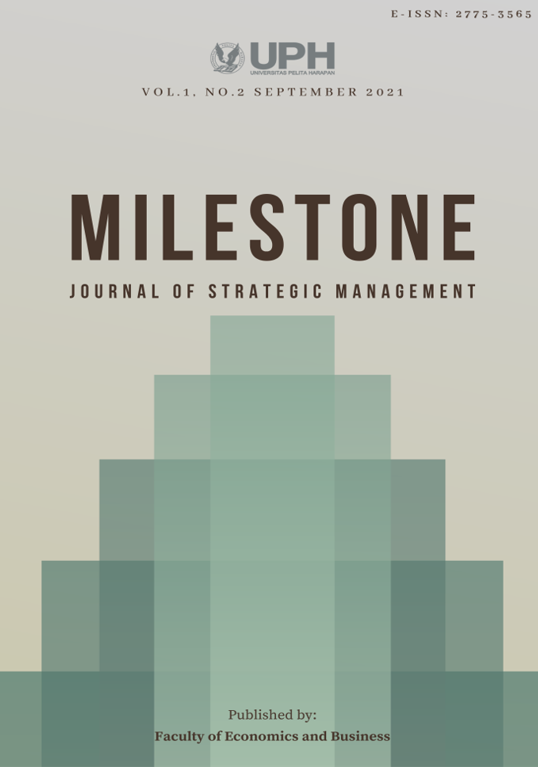University Strategy and Implementation Using the David Strategic-Management Model: A Case Study from Indonesia
DOI:
https://doi.org/10.19166/ms.v1i2.3932Keywords:
graduate competence, strategic planning, university, changeAbstract
The competency standards of university graduates must comply with the National Standards of Education, the Indonesian National Qualification Framework (KKNI), and other criteria set by the university. Universities need to set strategies and implementations to achieve the standard of graduate competence consisting of attitudes, knowledge, and skills stated in the formulation of graduate learning achievements. A case study using a qualitative approach was conducted at the university in Banten, Indonesia. The purpose of this study is to explore academic strategies in university. This includes examining the key drivers for strategic planning, the opportunities pursued in strategic planning, and challenges encountered in the process of strategic planning. The findings suggest that key drivers for strategic planning in the university include market competition and customer requirements. Secondly, the findings are the university should pursue three major strategic planning opportunities, including improved academic operational efficiency, improved student competency, and lecturer’s qualification, as well as improved services of the university. Thirdly, the change management process is reactive and not necessarily transformational in its degree, even though it can involve large-scale changes. The findings integrated into a model contribute to understanding the relationship between the context of strategic planning, the content of strategic planning, and the process of strategic planning in university.
References
Balogun, J., & Hailey, V. H. (2004). Exploring strategic change. Prentice Hall.
Cleland, D. I., & King, W. R. (1975). Systems analysis and project management. McGraw-Hill.
David, F. R., & David, F. R. (2017). Strategic management: A competitive advantage approach, concepts and cases (16th ed.). Pearson Education Limited.
Dworak, J. (2016). Positioning as a strategy-making tool in higher education. The WSB University in Poznan Research Journal, 71(6), 49-60.
Eisenhardt, K. M. (1989). Building Theories from Case Study Research. The Academy of Management Review, 14(4), 532-550. https://doi.org/10.5465/amr.1989.4308385
Hardani, Andriani, H., Ustiawaty, J., Utami, E. F., Istiqomah, R. R., Fardani, R. A., Sukmana, D. J., &Auliya, N. H. (2020). Metode penelitian kualitatif dan kuantitatif. CV Pustaka Ilmu.
Hassanien, M. A. (2017). Strategic planning in higher education, a need for innovative model. Journal of Education, Society and Behavioural Science, 1(11). 1-11. https://doi.org/10.9734/JESBS/2017/37428
Joibary, A. M., & Nagaraja, D. N. (2011). Integration of the BCG Matrix and Space Matrix for strategic planning codification: Case study for Islamic Azad University. Asian Journal of Development Matters, 5(1), 90-97.
Kementerian Pendidikan dan Kebudayaan, R. I. (2013). Peraturan Menteri Pendidikan dan Kebudayaan Republik Indonesia Nomor 73 Tahun 2013 tentang Penerapan Kerangka Kualifikasi Nasional Indonesia Bidang Pendidikan Tinggi.
Kolb, D. A., Lublin, S., Spoth, J., & Baker, R. (1986). Strategic management development: Using experiential learning theory to assess and develop managerial competencies. Journal of Management Development, 5(3), 13-24. https://doi.org/10.1108/eb051612
Kübler-Ross, E. (1969). On death and dying. Simon & Schuster, Inc.
Kusnandi. (2017). Konsep dasar dan strategi penjaminan mutu pendidikan: Sebagai review kebijakan mutu pendidikan. Indonesian Journal of Education Management & Administration Review, 1(2), 107-118. https://jurnal.unigal.ac.id/index.php/ijemar/article/view/942
Lunenburg, F. C. (2010). Total quality management applied to schools. Schooling, 1(1), 1-6.
Mintzberg, H. (1987). The strategy concept I: Five Ps for strategy. California Management Review, 30(1), 11-24. https://doi.org/10.2307/41165263
Palena, N., Shyam, T., & Boyce, C. (2006). Preparing a case study: A guide for designing and conducting a case study for evaluation input. Pathfinder International.
Porter, M. E. (1996). Competitive advantage, agglomeration economies, and regional policy. International Regional Science Review, 19(1-2), 85-94. https://doi.org/10.1177/016001769601900208
Rudzki, R. E. J. (1995). The application of a strategic management model to the internationalization of higher education institutions. Higher Education, 29(4), 421-441. https://doi.org/10.1007/BF01383961
Sallis, E. (2005). Total quality management in education (3rd ed.). Kogan Page Ltd.
Saunders, M., Lewis, P., & Thornhill, A. (2007). Research methods for business students (4th ed.). Pearson Education Limited.
Slikkerveer, L. J. (2019). Strategic management development in Indonesia. In L. J. Slikkerveer, G. Baourakis, & K. Saefullah (Eds.), Integrated community-managed development (pp 363-376). Springer. https://doi.org/10.1007/978-3-030-05423-6_18
Smirnovs, M., & Jamil, S. (2015). A systematic literature review on a managerial strategy "customer first" in software oriented organisations [Bachelor Thesis, Göteborgs Universitet]. GUPEA. http://hdl.handle.net/2077/38853
Susilo, W. (2018). Strategi menegakkan mutu pendidikan tinggi: Bebasis kerangka kualifikasi nasional Indonesia (D. Prabantini & FI. S. Suyantoro, Eds.). Andi.
Tahir, U. (2019, December 10). Kubler Ross change curve model. Change Management Insight. http://changemanagementinsight.com/kubler-ross-change-curve-model/
Yin, R. K. (2014). Case study research: Design and methods (5th ed.). SAGE.
Downloads
Published
Issue
Section
License
Authors who publish with this journal agree to the following terms:
1) Authors retain copyright and grant the journal right of first publication with the work simultaneously licensed under a Creative Commons Attribution License (CC-BY-SA 4.0) that allows others to share the work with an acknowledgement of the work's authorship and initial publication in this journal.
2) Authors are able to enter into separate, additional contractual arrangements for the non-exclusive distribution of the journal's published version of the work (e.g., post it to an institutional repository or publish it in a book), with an acknowledgement of its initial publication in this journal.
3) Authors are permitted and encouraged to post their work online (e.g., in institutional repositories or on their website). The final published PDF should be used and bibliographic details that credit the publication in this journal should be included.





